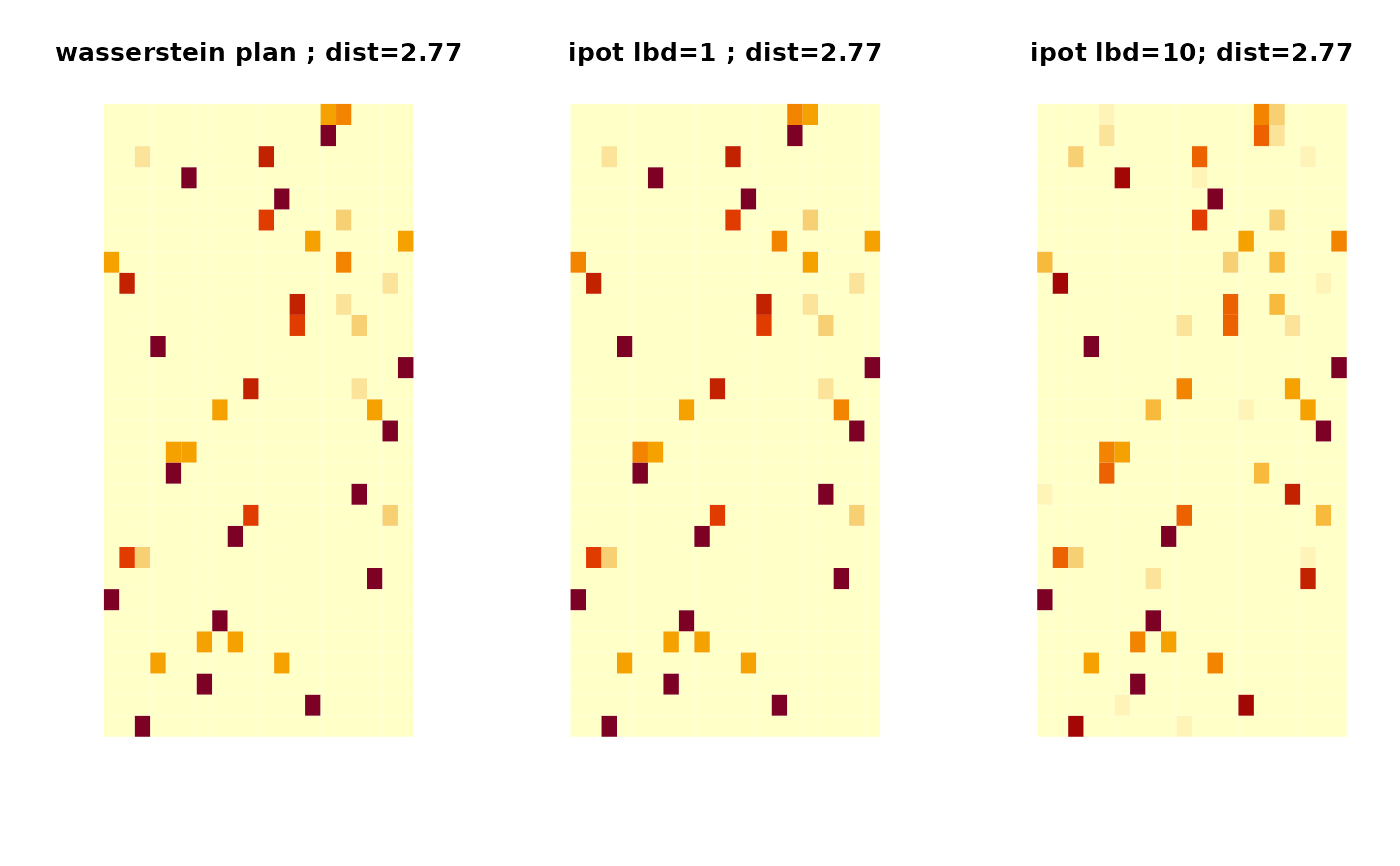Wasserstein Distance via Inexact Proximal Point Method
ipot.RdThe Inexact Proximal Point Method (IPOT) offers a computationally efficient approach to approximating the Wasserstein distance between two empirical measures by iteratively solving a series of regularized optimal transport problems. This method replaces the entropic regularization used in Sinkhorn's algorithm with a proximal formulation that avoids the explicit use of entropy, thereby mitigating numerical instabilities.
Let \(C := \|X_m - Y_n\|^p\) be the cost matrix, where \(X_m\) and \(Y_n\) are the support points of two discrete distributions \(\mu\) and \(\nu\), respectively. The IPOT algorithm solves a sequence of optimization problems: $$ \Gamma^{(t+1)} = \arg\min_{\Gamma \in \Pi(\mu, \nu)} \langle \Gamma, C \rangle + \lambda D(\Gamma \| \Gamma^{(t)}), $$ where \(\lambda > 0\) is the proximal regularization parameter and \(D(\cdot \| \cdot)\) is the Kullback–Leibler divergence. Each subproblem is solved approximately using a fixed number of inner iterations, making the method inexact.
Unlike entropic methods, IPOT does not require \(\lambda \rightarrow 0\) for convergence to the unregularized Wasserstein solution. It is therefore more robust to numerical precision issues, especially for small regularization parameters, and provides a closer approximation to the true optimal transport cost with fewer artifacts.
Usage
ipot(X, Y, p = 2, wx = NULL, wy = NULL, lambda = 1, ...)
ipotD(D, p = 2, wx = NULL, wy = NULL, lambda = 1, ...)Arguments
- X
an \((M\times P)\) matrix of row observations.
- Y
an \((N\times P)\) matrix of row observations.
- p
an exponent for the order of the distance (default: 2).
- wx
a length-\(M\) marginal density that sums to \(1\). If
NULL(default), uniform weight is set.- wy
a length-\(N\) marginal density that sums to \(1\). If
NULL(default), uniform weight is set.- lambda
a regularization parameter (default: 0.1).
- ...
extra parameters including
- maxiter
maximum number of iterations (default: 496).
- abstol
stopping criterion for iterations (default: 1e-10).
- L
small number of inner loop iterations (default: 1).
- D
an \((M\times N)\) distance matrix \(d(x_m, y_n)\) between two sets of observations.
Value
a named list containing
- distance
\(\mathcal{W}_p\) distance value
- plan
an \((M\times N)\) nonnegative matrix for the optimal transport plan.
References
Xie Y, Wang X, Wang R, Zha H (2020-07-22/2020-07-25). “A Fast Proximal Point Method for Computing Exact Wasserstein Distance.” In Adams RP, Gogate V (eds.), Proceedings of the 35th Uncertainty in Artificial Intelligence Conference, volume 115 of Proceedings of Machine Learning Research, 433–453.
Examples
# \donttest{
#-------------------------------------------------------------------
# Wasserstein Distance between Samples from Two Bivariate Normal
#
# * class 1 : samples from Gaussian with mean=(-1, -1)
# * class 2 : samples from Gaussian with mean=(+1, +1)
#-------------------------------------------------------------------
## SMALL EXAMPLE
set.seed(100)
m = 20
n = 30
X = matrix(rnorm(m*2, mean=-1),ncol=2) # m obs. for X
Y = matrix(rnorm(n*2, mean=+1),ncol=2) # n obs. for Y
## COMPARE WITH WASSERSTEIN
outw = wasserstein(X, Y)
ipt1 = ipot(X, Y, lambda=1)
ipt2 = ipot(X, Y, lambda=10)
## VISUALIZE : SHOW THE PLAN AND DISTANCE
pmw = paste0("Exact plan\n dist=",round(outw$distance,2))
pm1 = paste0("IPOT (lambda=1)\n dist=",round(ipt1$distance,2))
pm2 = paste0("IPOT (lambda=10)\n dist=",round(ipt2$distance,2))
opar <- par(no.readonly=TRUE)
par(mfrow=c(1,3), pty="s")
image(outw$plan, axes=FALSE, main=pmw)
image(ipt1$plan, axes=FALSE, main=pm1)
image(ipt2$plan, axes=FALSE, main=pm2)
 par(opar)
# }
par(opar)
# }